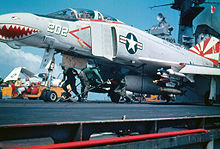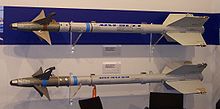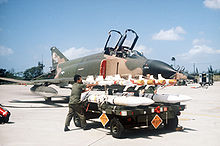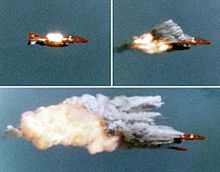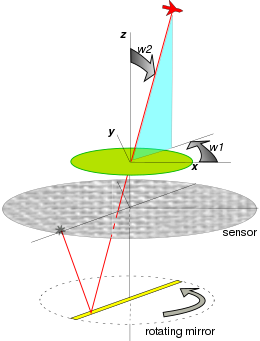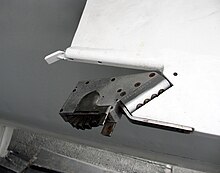AIM-9 Sidewinder
| AIM-9 Sidewinder | |
|---|---|
| General Information | |
| Type | Air-to-air missile |
| Manufacturer | Raytheon (among others) |
| development | 1952 |
| Commissioning | 1956 |
| Unit price | AIM-9X: $ 262,000 |
| Technical specifications | |
| length | 2830-3070 mm |
| diameter | 127 mm |
| Combat weight | 70.4-88.5 kg |
| span | 279.4 mm |
| drive | Solid rocket engine |
| speed | Mach 2-2.7 |
| Range | 4.8-17.7 km |
| Furnishing | |
| Target location | passive infrared steering |
| Warhead | 9.4 kg |
| Weapon platforms | Fighter planes |
| Lists on the subject | |
The AIM-9 Sidewinder is a heat-seeking short-range air-to-air guided missile made in the USA for use by combat aircraft and attack helicopters . A modified version was also used in the ground-based MIM-72 Chaparral . In the course of its 50-year history, more aircraft have been shot down with the Sidewinder than with any other missile.
When looking for a target, the Sidewinder orients itself by its thermal radiation using a thermal optical target detector. Behind it are the warhead and in the stern the rocket motor. The guidance system guides the missile directly into the enemy's hot engines (or whatever the missile thinks it is) with the help of tail surfaces. An infrared unit costs less than any other steering system and is suitable for all weather conditions to a limited extent. The infrared seeker head also gives the missile real fire-and-forget capabilities, which means that after take-off the missile no longer needs any support from the firing platform and steers itself to the target.
history
The AIM-9 was developed by the US Navy from the late 1940s onwards by a development team at the Naval Ordnance Test Station of the US Navy in China Lake, California, under the direction of William B. McLean. It used some new techniques that made it easier and more reliable than its Air Force counterpart , the AIM-4 Falcon . After the Falcon performed unsatisfactorily in the Vietnam War , the Air Force replaced it with Sidewinders.
The company Philco (later Ford Aerospace) received the order in 1951 to develop a rocket based on the findings of the Navy team. A prototype of the Sidewinder, the AIM-9A, was successfully fired for the first time on September 11, 1953, with a converted F6F-5K as a target. The first production version AIM-9B was delivered from spring 1956 as AAM-N-7 to the Navy and as GAR-8 to the Air Force. The first series versions were initially called Sidewinder I or IA, later as AIM-9A or AIM-9B. Since it has been continuously improved since then, this led to a large number of different versions, which was additionally reinforced by the fact that in the 1960s and 70s the US Navy and the US Air Force operated the further development of the Sidewinder separately from each other . The reasons for this lay mainly in the traditional rivalry between these two branches of the armed forces, but also in the different requirement profiles during this time. Air combat against enemy fighters and fighter-bombers was much more important in the operational doctrine of US naval aviators than in the Air Force, which placed its main priority on fighting relatively sluggish bombers at high altitudes. The first models only achieved a range of about 4 km, could only be fired from behind at an aircraft and were still quite easily distracted by clouds, reflections, the sun and similar influences.
The Bambini Code of the Swiss Air Force for the Sidewinder is Siwa .
overview
| AIM-9A | |||||||||||||||||||||||||||||||||||||||||||
| AIM-9B | |||||||||||||||||||||||||||||||||||||||||||
| AIM-9E | AIM-9F | AIM-9D | AIM-9C | ||||||||||||||||||||||||||||||||||||||||
| AIM-9J | AIM-9G | MIM-72 | AGM-122 sidearm | ||||||||||||||||||||||||||||||||||||||||
| AIM-9N | AIM-9H | ||||||||||||||||||||||||||||||||||||||||||
| AIM-9P | AIM-9L | ||||||||||||||||||||||||||||||||||||||||||
| AIM-9S | AIM-9M | ||||||||||||||||||||||||||||||||||||||||||
| AIM-9R | |||||||||||||||||||||||||||||||||||||||||||
| AIM-9X | |||||||||||||||||||||||||||||||||||||||||||
Versions
- AIM-9B
- First serial version with uncooled 70 Hz lead sulfide (PbS) detector seeker head with 4 ° field of view and rotating mirror, 25 ° squint angle and a target tracking rate of 11 ° / s. Gas generator to supply energy for the 20 s flight time and a gas bottle to cool the electrical components. Warhead with fragmentation effect, that of a passive infrared - proximity fuse is triggered. Passive means that the detonator is triggered by the (infrared) thermal radiation emanating from the target object's engine and that it does not - as with active methods - itself emit an electromagnetic wave and evaluate its reflections. Served as the basis of the AGM-87 Focus air-to-surface missile .
- AIM-9C
- Version with semi-active radar seeker head , improved Rocketdyne MK36 rocket motor with 60 s burn time (and thus greater range), larger control surfaces and more powerful actuators. Only briefly used by the US Navy on the Vought F-8C Crusader . Remnants converted to the anti-radar missile AGM-122 Sidearm .
- AIM-9D
- Version with nitrogen-cooled 125 Hz seeker head with reduced 2.5 ° field of view, 27 ° squint angle and increased target tracking rate to 12 ° / s. Increased range and maneuverability thanks to the oval nose profile for lower air resistance, more powerful rocket motor with longer burning time, larger control surfaces, more powerful actuators and a new gas generator for up to 60 seconds of controlled flight time. Installation of an improved warhead with a new proximity fuse. Marine variant.
- AIM-9E
- Improved AIM-9B with Peltier-cooled 100 Hz seeker head with a target tracking rate increased to 16.5 ° / s in an elongated conical nose. Air Force variant. Listed as AAM-1 by the Japanese Air Force .
- AIM-9F
- Also known as AIM-9B FGW2. Improved variant of the AIM-9B, with a new CO 2 -cooled seeker head with a target tracking rate of 16 ° / s, in which more reliable solid-state electronics were used instead of tube technology. This variant was developed and built by Bodenseewerk Geräteechnik GmbH for the German Air Force. It was not used in the American armed forces.
- AIM-9G
- Improved version of the AIM-9D with new target acquisition modes (SEAM, Sidewinder Extended Acquisition Mode ). These make it possible to assign a target to the seeker head using the on-board radar or to let the seeker head scan the area in front of the launch platform in a special grid. Furthermore, a target assignment could also be made using a helmet visor. This option was only used in connection with the F-4N and F-4S Phantom II and was no longer pursued after the introduction of the McDonnell Douglas F / A-18 until the introduction of the AIM-9X variant. Marine variant.
- AIM-9H
- Another improvement to the G version with new control electronics that used more reliable semiconductor components instead of electron tubes that were prone to failure . Increased target tracking rate to 20 ° / s and stronger actuators. Marine variant.
- AIM-9J / N
- Further development of the AIM-9E from the beginning of the 1970s, during which the electronics were partially switched from electron tubes to semiconductor components. Installation of a new gas generator for up to 40 seconds of controlled flight time and new control surfaces with characteristic angular double delta canards to increase maneuverability. The AIM-9N variant, initially also called AIM-9J-1, has revised electronics compared to the basic variant and was primarily intended for export. Air Force variant.
- AIM-9L
- Greatly improved version of the Sidewinder based on the AIM-9H, which was produced in series from 1977. Use of an FM-modulated argon-cooled indium antimonide seeker head, which for the first time also allowed the acquisition of targets from the frontal hemisphere, while previous sidewinder versions could only be fired at a target from behind. Revised control surfaces in the form of tapered double canards. Use of a revised warhead with an active laser proximity fuse. Use by both the Air Force and the Navy and the termination of the Sidewinder lines of development, which are separated according to the armed forces. The AIM-9L / i is a sub-variant produced under license by Bodenseewerk Geräteechnik with improved suppression of IR countermeasures. It was also made in Japan.
- AIM-9M
- Revised AIM-9L with low-smoke rocket motor MK36 Mod.11, revised electronics and better suppression of IR countermeasures ( IRCM ). Various sub-variants with application and user-specific modifications.
- AIM-9P
- Improved variant AIM-9J / N with different sub-variants. P-1: Use of the active laser proximity fuse of the AIM-9L. P-2: Use a low-smoke rocket motor. P-3: Combination of the two previous variants. P-4: Use of an all-aspect seeker head similar to that of the AIM-9L. P-5: Improvement of P-4 with increased insensitivity to IR interfering measures. The AIM-9P was originally designed as a reduced-power export variant to supplement the AIM-9L, but due to its comparatively lower costs and the possibility of upgrading existing AIM-9J / Ns, it was also ordered in larger numbers by the US Air Force.
- AIM-9R
- Variant of the Sidewinder with imaging IR seeker head. Development stopped at the end of the 1980s for cost reasons.
- AIM-9S
- Export variant of the AIM-9M.
The Sidewinder is the most widely used air-to-air missile by NATO countries and some American allies. It is one of the oldest, cheapest, and most successful missiles in the US weapons inventory.
There is also a training version, the ATM-9L . This has no rudder fins and no rocket motor. It is not fired, but serves the target systems of the aircraft and the pilot as a training object for the acquisition of targets, since the seeker head is fully functional.
AIM-9X model
After western armed forces came into possession of Soviet weapons systems as a result of the end of the Cold War and German reunification, it was found that the most modern close combat air-to-air missile of the Eastern bloc, the Wympel R-73 / A-11 Archer, was the western one at that time Was far superior to its counterpart in almost all relevant parameters. This came as a surprise to the NATO armed forces, as it had previously been assumed that Soviet missile systems were less developed and that in the future, at best, guided missiles in the performance class of the AIM-9L / M would have to be expected. It was therefore decided to develop a new air-to-air missile to catch up with Russian developments.
Originally it was considered to replace the Sidewinder with the British AIM-132 ASRAAM , but constant delays due to disputes over the conceptual design of the missile between Great Britain and the then ASRAAM project partner Germany led to the US ending these plans. Instead, a separate program for the new short-range air-to-air missile AIM-9X was started in 1994 .
The AIM-9X is still assigned to the AIM-9 series, but it is a completely new development that only uses a few components of its predecessor. Proven components such as the low-smoke rocket motor and the warhead were adopted from the AIM-9M. What is new is the rocket body, which has significantly less air resistance than previous versions and is now controlled via the tail fins and no longer via the front canards. In connection with a likewise new thrust vector control , a significantly better maneuverability is achieved.
A major advance compared to the previous AIM-9 models is the imaging IR seeker head, the heart of which is an image sensor as a focal plane array with 128 × 128 elements. This has a greater maximum detection range than the seeker heads of earlier sidewinders and can reliably distinguish the actual target from disruptive measures by evaluating the IR image . In addition, targets can be captured up to 90 ° away from the flight direction, while older models of the AIM-9 series are limited to 27.5 ° here. The rocket now uses a digital computer for control , the microprocessor of which can process much more complex data and algorithms.
Communication between the missile and the platform's fire control computer is now being handled digitally for the first time. Newer aircraft have mastered this mode for several years; For platforms where retrofitting is no longer worthwhile ( F-14 , AV-8B and AH-1 Cobra ), the rocket has an analog compatibility mode in which it behaves like an AIM-9M and also so in relation to the fire control computer identified.
Series production of the missile started at the end of 2002, and the first ready-to-use samples were seen during Operation Iraqi Freedom in 2003. Whether or not it was used there is currently still kept secret.
From December 2007, Switzerland received the first AIM-9X for its F / A-18 Hornet fighter aircraft as a replacement for the previous model AIM-9P.
To date, over 4,500 guided missiles have been shipped at a price of approximately $ 320,000 each. The US Air Force and the US Navy alone are planning to purchase a total of 10,142 rockets, bringing the budget to around three billion US dollars. In July 2011 the further developed Block II version will go into production at Raytheon.
Model AA-2 Atoll
A special Sidewinder variant is the Soviet R-3 / AA-2 Atoll , the first version of which was an exact copy of the American AIM-9B. How the Soviet Army got hold of a Sidewinder has not yet been fully clarified. By 1967 at the latest, the Soviet developers had a Sidewinder at their disposal, which the Krefeld architect Manfred Ramminger, with the help of his driver and Starfighter pilot Wolf-Diethard Knoppe , had stolen from the West German air base in Neuburg on October 22, 1967 . The rocket was later - dismantled into unsuspicious parts - transported to Moscow via Düsseldorf Airport. The trio were arrested a year later. However, it is also considered likely that the Soviets had a Sidewinder as early as 1958, which was detonated in the fuselage during an air battle between a national Chinese F-86 Saber and a MiG-17 of the People's Republic of China on September 24, 1958 over the Strait of Formosa the MiG got stuck and came to the Soviet Union via China. Compared to the previous complex Soviet in-house developments, the Sidewinder was very simple. Since it was first used in Vietnam, improvements were made to the Soviet in-house developments, which, due to their low procurement costs, became particularly interesting for export to third world countries.
commitment
The AIM-9 was first used during the Second Quemoy Crisis . On September 24, 1958, a Taiwanese F-86 Saber fired a Sidewinder at a MiG-15 of the People's Republic of China.
During the Vietnam War , the AIM-9 initially achieved a hit rate of 65%. This sank to 15% by the end of the war.
During the Falklands War , British Harrier fired 26 AIM-9L at Argentine air targets and scored 19 hits. This corresponds to a hit rate of 73%.
During the Second Gulf War , 48 AIM-9Ms fired 11 hits. This corresponds to a hit rate of 23%.
During the downing of a Syrian Su-22 over Syria on June 18, 2017, an AIM-9X was most likely used in combat for the first time. However, the missile was deflected by the decoys of the Su-22 and missed its target, although it was launched from a very short distance. This corresponds to a hit rate of 0%.
The F / A-18 from the US aircraft carrier USS George HW Bush was only successfully shot down with a second rocket launched afterwards, a radar-controlled AIM-120 AMRAAM .
technology
construction
The missile consists of four main sections: target acquisition, guidance, warhead and rocket motor. These are mainly housed in an aluminum tube with a diameter of 12.7 cm.
The Guidance and Control Unit (GCU) contains most of the missile's electronics and mechanics. At the tip of the rocket, behind a glass dome, sits the IR seeker head with the rotating spindle, the mirror and five lead sulfide - or from the AIM-9L variant indium antimonide - photoresistors or a focal plane array on the AIM-9X. Behind it lies the electronics that collect data, interpret signals and generate control signals. An electrical connection leads from the GCU to the aircraft's launch rail. The electronics are cooled using an argon bottle or liquid nitrogen (AIM-9X). At the rear end of the GCU, a gas generator or a thermal battery (AIM-9X) provide electrical energy. This is followed by the detonator with eight IR emitters and detectors that detonate the warhead near the target. Versions before the AIM-9L also had a magneto. Since shielded cabling and non-magnetic metals are increasingly being used in military aircraft construction, the magneto would be relatively useless today.
The latest models of the AIM-9 have a warhead with a spherical fragmentation effect. It consists of spirally wound spring steel and is filled with 6 kg of Tritonal .
The solid rocket motors for all Sidewinder variants are supplied by Orbital ATK . Smoke-reduced hydroxyl-terminated polybutadiene (HTPB) is used as fuel.
The propulsion section with the solid rocket motor also contains three connectors that connect the missile to the launch rail. The engine is ignited via electrical contacts in the rail and the warhead is pre-sharpened. In all older models, the tail fins are only used for aerodynamic stabilization, while the front wings are used for steering. With the AIM-9X this has been reversed for the first time. Therefore it became necessary to install wiring harnesses along the entire missile.
Function of the infrared aiming system
The main advantage of the Sidewinder was its simple but effective aiming and steering system, which uses a combination of mechanics and analog computers , since digital computers with sufficient power and compactness were not available at the time of development. This only changed in the mid-1990s with the AIM-9X.
During World War II , the Germans had already experimented with infrared guidance systems in a large missile known as the Enzian ; However, the end of the war prevented further development. The Enzian had an IR detector mounted in a small movable telescope and used a metal flag in front of the mirror to determine which side of the center the target was on for guidance. When the rocket moved continuously in the current direction of the telescope, it steered itself towards the target on a so-called tow course .
The Sidewinder improved this in several ways: First, the rigid mirror was replaced by one that rotated around a shaft. Instead of fixing the target in the mirror, the IR sensor would see the target as a series of short flashes. If it was known where the lightning bolt was on the rotating mirror, the radial direction to the target resulted, in the image w1 . In addition, the system was able to cleverly determine the angle of deviation, w2 , to the target. If the target moved sideways out of the field of view, the flash was shorter due to the higher speed of movement on the outside of the mirror.
This type of signal improved the target tracking system: Instead of simply directing the missile to the current position of the target - which is unfavorable as it usually moves on quickly - the steering system of the Sidewinder “memorized” the direction and duration of each lightning bolt. She then tried to zero out the changes in movement of the target in the mirror instead of keeping the difference between the angle of the detector and that of the missile at zero. If the target stopped in the viewfinder, the missile was exactly on the shortest path to the target, this course is also called the interception course .
However, the whole system was dependent on the missile not rotating around its longitudinal axis, since in this case the timing, which is dependent on the rotation speed of the mirror, would no longer be correct. Correcting this rotation would normally require a position sensor in order to counteract accordingly. Instead, the Sidewinder engineers found a simpler solution: At the rear of the missile, small control surfaces with rotating disks (gears) were attached to the surface ("rollerons"). Air flow over the discs made them spin faster; when the missile began to roll, the gyroscopic force that would act on the disks pushed the control surfaces into the airflow and stopped the roll motion. So the Sidewinder team replaced a complex control system with four small pieces of metal.
Target acquisition with the Sidewinder can be done in several ways: On the one hand, the rocket can independently search the sky in front of its swiveling seeker head; if it has detected a heat source, it signals this to the pilot via an audio signal (a high-pitched whistle depending on the quality of target acquisition). On the other hand, there is the tracking mode, in which the pilot activates a target with his on-board radar. The radar then tells the missile the angle to the target; this swings its seeker head there and records the target. The new AIM-9X also has a third mode. Here the pilot's helmet is coupled with a sensor that reports the current direction of view of the pilot to the missile. To fire a missile, all the pilot has to do is look at the target and pull the trigger. This is particularly useful in extreme close combat , when the distance to the use of radar is too short, or useful for helicopters .
Technical specifications
| Type | steering | Length in m |
Starting weight in kg |
Vmax in mach |
Range in km |
Remarks |
|---|---|---|---|---|---|---|
| AIM-9B | Infrared | 2.83 | 70.4 | 2 | 4.8 | from 1956 |
| AIM-9C | semi-active radar | 2.87 | 84 | 2 | 17.7 | |
| AIM-9D | Infrared | 2.87 | 88.5 | 2 | 17.7 | |
| AIM-9J | Infrared | 3.07 | 78 | 2 | 14.5 | from the early 1970s |
| AIM-9L | Infrared | 2.85 | 85.3 | 2 | 17.7 | from 1977 |
| AIM-9M | Infrared | 2.85 | 86 | 2.5 | 17.7 | from 1982 |
| AIM-9P | Infrared | 3.07 | 78 | 2.5 | 17.7 | |
| AIM-9X | Infrared | 2.90 | 85.5 | 2.7 | 16 | from 2002 |
| MAA-1 | Infrared | 2.72 | 86 | 2 | 16 | Brazilian version |
| PL-2 | Infrared | 2.88 | 70 | 2 | 7.8 | |
| PL-5B | Infrared | 2.89 | 85 | 2 | 16 | |
| Shafrir 2 | Infrared | 2.47 | 93 | 2.5 | 5 | Israeli in-house development based on the Sidewinder |
| AAM-1 | Infrared | 2.60 | 70 | 2 | 7th | Japanese version |
| Kukri V3 | Infrared | 2.94 | 73.4 | 2.5 | 6th | South African version |
| Tien Chien 1 | Infrared | 2.87 | 90 | 2 | 15th | Taiwanese version |
| R-3S | Infrared | 2.84 | 75.3 | 2 | 7th | from 1960 |
| R-3R | semi-active radar | 3.42 | 82.4 | 2 | 8th | |
| R-13M | Infrared | 2.87 | 88.2 | 2.5 | 13 | with rod jacket warhead |
AIM-9X details:
- Manufacturer: Raytheon ; Ford Aerospace; Loral; Diehl Defense ;
- Drive: Thiokol Hercules and Bermite MK 36 Mod 11; single stage solid rocket engine
- Diameter: 12.7 cm
- Span: 44 cm
- Speed: Mach 2.7 up to (depending on the model type) Mach 4.7
- Warhead: HE fragment; 10.5 kg
- Delivery: from 2002
- Users: Australia, Belgium, Denmark, Finland, Indonesia, Israel, Japan, Qatar, Kuwait, Malaysia, Morocco, Netherlands, Norway, Oman, Poland, Saudi Arabia, Switzerland, Singapore, South Korea, Taiwan, Turkey, United Arab Emirates, United States
literature
- Ron Westrum: Sidewinder . Creative Missile Development at China Lake. Naval Institute Press, 2013, ISBN 978-1-61251-363-8 (English, limited preview in Google Book Search).
Web links
- Carlo Kopp: The Sidewinder Story. The Evolution of the AIM-9 Missile. In: Australian Aviation, April 1994 (English).
- Andreas Parsch: Raytheon (Philco / General Electric) AAM-N-7 / GAR-8 / AIM-9 Sidewinder. In: Directory of US Military Rockets and Missiles, July 2008.
Individual evidence
- ↑ a b c FliegerRevue July 2010; Pp. 28-30; Snappy sidewinder
- ↑ Briefly noted. In: Flug Revue , September 2011, p. 50.
- ↑ a b c http://www.ausairpower.net/APA-NOTAM-170209-1.html
- ↑ Dave Majumdar: Why the US Military Doesn't Always Dominate. (No longer available online.) In: scout.com. Archived from the original on June 26, 2017 ; accessed on June 26, 2017 (English).
- ↑ Ryan Browne: New details on US shoot down of Syrian jet. In: edition.cnn.com. June 22, 2017, accessed June 26, 2017 .
- ↑ Alex Lockie: How a US F / A-18 shot down the first manned enemy plane since 1999. In: businessinsider.de. June 22, 2017, accessed June 26, 2017 .
- ↑ Jim Winchester: Syrian shoot-down marks first 'kill' for Super Hornet. In: flightglobal.com. June 19, 2017, accessed June 26, 2017 .
- ↑ http://www.orbitalatk.com/defense-systems/missile-products/sidewinder/ accessed on February 7, 2016



